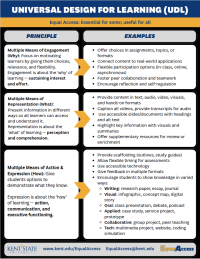
Instructional Accessibility
Instructional Accessibility ensures all students can participate and succeed by reducing barriers in teaching and course design. Using Universal Design for Learning (UDL), inclusive communication, and proactive planning, instructors provide multiple ways for students to engage, access materials, and show knowledge. This approach meets legal responsibilities, fosters equity, and strengthens learning for the entire classroom community.
Universal Design for Learning
Universal Design for Learning (UDL) is a proactive approach: design courses from the start to be flexible, accessible, and inclusive so that all students can engage, learn, and demonstrate knowledge effectively. UDL is a framework for designing instruction that anticipates learner diversity. It focuses on removing barriers rather than retrofitting accommodations and benefits all students, not just those with disabilities. UDL is grounded in neuroscience, emphasizing three core areas: engagement, representation, and action/expression.
Campus Partners
Student Accessibility Services (SAS)
Academic, housing, and transportation accommodations for students.
Phone: 330-672-3391 | Email: sas@kent.edu
Web: /sas
Kent State Online
Support for creating and delivering accessible course content through Canvas.
Email: online@kent.edu
Web: /kso
Center for Teaching & Learning (CTL)
Training and support for inclusive, accessible instruction and course design.
Phone: 330-672-2992 | Email: ctl@kent.edu
Web: /ctl
Digital Accessibility Team
Support for testing and editing technology and content for better accessibility.
Email: equalaccess@kent.edu
Web: /digitalaccessibility


